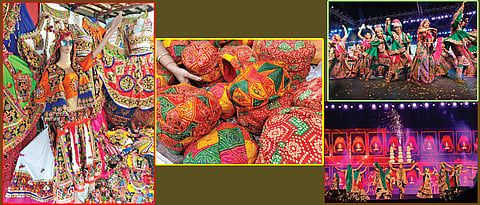

As monsoon begins its return journey, people in India start getting ready for the festivities. The first day of the Hindu month of Ashwin marks the onset of Navratri, the festival of nine nights devoted to Goddess Shakti.
Actually, different parts of the country have different ways of celebrating this festival, though the fervour remains the same everywhere. It is known as Navratri in Gujarat, Durga Puja in West Bengal and Dussera in the North.
Navratri is the best time to visit Gujarat. People wait for the whole year to put on their dancing shoes, pick up colourful dandiya sticks and make garba moves over foot-tapping music. The main highlight is the folk dance of Gujarat called Rasa Garba and everyone has a common destination in the evening — the Garba ground.
All of Gujarat is beautifully decorated with lights and each day of the fiesta begins with the performance of aarti. On the first day, wheat seeds are sown in an earthen pot for puja and the sprouts are distributed as prasad on the eighth and ninth day; after offering prayers to Goddess Durga.
The way people celebrate the victory of Ma Jagdamba (Shakti) over demon Mahishasur after a fight for nine days in Gujarat has been luring me for long, and this year finally I was lucky enough to go over to Ahmedabad and Vadodara and participate in the festivities.
MY EXPERIENCE IN GUJARAT
So here I was in Ahmedabad on the first day of Navrati 2019. Without wasting time, I went to the Heritage market to shop for colourful chaniya choli with matching jewellery for my lady colleagues and kafni-pyjama for myself. Oh yes, after this, it was time for a traditional Gujarati Thali meal before the evening set in.
I came to learn later in the evening about the religious significance and proceedings of the festival. It started with people doing “Devi-sthaapna” or setting up a shrine of the goddess in their homes. This shrine has a garbo (an earthenware pot), in which betel nut, coconut and a silver coin are placed. Every night, before playing Dandiya, another form of Gujarati dance which is performed with short sticks while moving in a circular manner to music, devotees gather to perform a puja of one of the nine forms of the goddess.
In Ahmedabad, the festival kicked off at the huge GMDC ground where the state chief minister gave a green signal, followed by an aarti and various cultural performances. And then it was the turn of all of us — men and women — present there, to begin the Garba dance, one of the most colourful dance forms.
We formed a circle and danced in synchronised steps along with a lot of clapping and twirling around a clay lantern with earthen lamps. We also played Dandiya. Mythologically, it represents the mock-fight between the goddess Durga and the demon Mahishasura.
During this nine-day festival, the whole city turns quite lively — everybody seems to be on the road at night. Besides the GMDC ground, the city has local clubs like Rajpath, Karnavti and YMCA where Garba is played.
The next day, we moved to Vadodara, the cultural capital of Gujarat. The festival is celebrated with much fanfare there too. The city has many places to play Garba, and we went to the most happening among them — United Way Ground. I was lost in the sea of people playing Garba in a very lively ambience. The music was played by renowned singers and dancers and it is estimated that every day more than 30,000 people visit the place.
After two evenings of non-stop Garba and Dandiya, I went around areas near Vadodra and enjoyed other tourist attractions namely, the Statue of Unity — the symbol of pride for every Indian.
